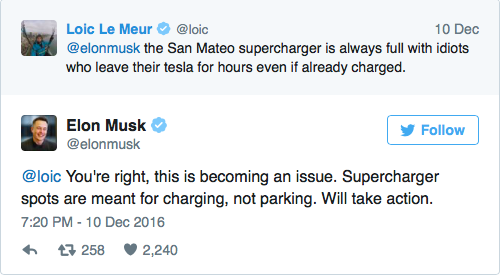Jun 20, 2017
Respond to Customer Complaints like a CEO
Customer complaints are broadcast more widely now than ever on social media platforms like Facebook, Twitter, and Yelp. Where once customers had to call or write in directly to voice a complaint, they can now post their feedback directly to the company or CEO’s social media page. This means that customer complaints have the power to affect company sales, credibility, and customer trust in a whole segment of socially tuned-in consumers.
But don’t let that scare you off. Negative customer feedback can be a great tool for growth. It provides insight into what’s working with the product or service and what’s not. It’s also an opportunity to build a deeper, more meaningful relationship with a customer. Did you know that 65% of customers who had a negative experience that was resolved with a positive outcome referred others to that company?
See how these famous CEOs responded quickly, thoughtfully, and effectively to these customer complaints.
Steve Jobs, late CEO of Apple
Reportedly, after buying a 15-inch MacBook Pro and a 22-inch monitor, a man named Aaron Booker was surprised to find out that he wasn’t eligible for a discount on AppleCare because he hadn’t bought another similarly priced computer. Booker emailed Steve Jobs directly (then: sjobs@apple.com), explaining the issue, and received a short but definitive affirmation from Jobs: “We’ll fix this.” The next day Booker says he “got a call from one of Steve’s assistants and the problem was solved.”
Mickey Drexler, former CEO of J. Crew
After receiving a J. Crew coupon in the mail, Mike Beaulieu went down to the store and picked something out. But when tried to use the coupon at the register the sales associate wouldn’t accept it, even suggesting that it was a forgery. When he got home, he emailed J.Crew CEO Mickey Drexler about the incident and got a response within 15 minutes:
Terrible on our part! No excuses. My apologies! We will be in touch.
Best,
Mickey
Elon Musk, CEO of Tesla
Lois Le Meur wanted to charge his Tesla but arrived to find all the charging stations full of idle cars.
So he took to Twitter to reach the Tesla CEO directly:

Just six days later Tesla announced the following policy on its website:
We designed the Supercharger network to enable a seamless, enjoyable road trip experience. Therefore, we understand that it can be frustrating to arrive at a station only to discover fully charged Tesla cars occupying all the spots. To create a better experience for all owners, we’re introducing a fleet-wide idle fee that aims to increase Supercharger availability.
The announcement informed Tesla owners that the company’s app will alert them once their car’s charge is almost complete, and that “For every additional minute a car remains connected to the Supercharger, it will incur a $0.40 idle fee.” The fee is then waived if the car is moved within five minutes.
Tips to Respond Like a CEO
When responding to customer complaints remember the following tips: embrace complaints, listen to the customer, and monitor the results.
Embrace customer feedback (even if comes in the form of a complaint)
While it may seem easy to disregard some complaints, Mitch Lowe, Netflix founding executive and current CEO of Movie Pass, explains that customer complaints are actually a great way to get feedback: “One place that we can garner an understanding of what’s not working and where improvements need to be made is in the customer service department.” Lowe explains
I have always found the customer service department to be the most in touch with our customers and more transparent than the sales or marketing departments… More importantly, it is critical that you know which segment of your customer’s complaints will impact customer satisfaction and loyalty, and the growth of your sales most positively.
Lowe suggests you segment your customers into three groups using Professor Ed Richfield’s NPS system. “I look at the complaints most commonly voiced by the group labeled ‘Passively Satisfied’ or those that rate your service a 7 or 8 on a scale of 0 to 10 and focus on fixing those issues first.” Mitch utilizes this system at MoviePass and says it “has led to dramatic double-digit growth primarily through organic word of mouth.”
Listen to the customer and solve the problem quickly (social media helps with this)
Take a page from Musk’s game plan in the Tesla charging station incident. He proved that when it comes to customer service, listening to the customer and alleviating their pain points with the product are key to customer satisfaction. He also proved that when used correctly, social media is a great platform to accomplish this. Musk regularly replies to customer questions on Twitter and uses those interactions to gain insight into his customer experiences with the product and to share his latest big ideas.
Monitor the results and follow-up
After responding in a timely manner, offering an apology and a solution to the customer, it’s important to follow up on your promise to amend the issue. Take Steve Jobs and Aaron Booker’s complaint, for example. Aaron received a call from Jobs’s assistant the very next day and the problem was solved. Monitoring and follow-up ensure that a solution has been implemented and the outcome meets the customer’s expectations.
Many businesses fail to realize the true value of negative customer feedback. But it is the companies that take advantage of these opportunities for growth that have the highest probability of customer satisfaction and long-term success.
The content writers at BigSpeak Speakers Bureau are Experts on the Experts. They hold doctoral, masters, and bachelors’ degrees in business, writing, literature, and education. Their business thought pieces are published regularly in leading business publications. Working in close association with the top business, entrepreneur, and motivational speakers, BigSpeak content writers are at the forefront of industry trends and research.
Tags
